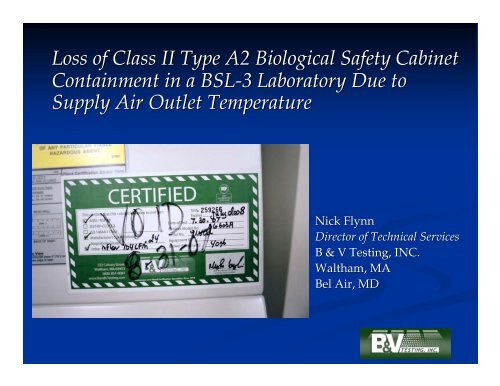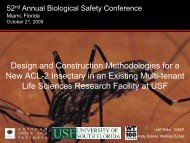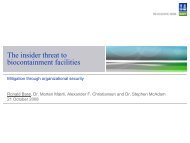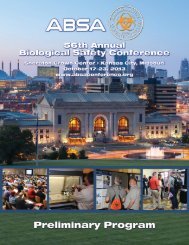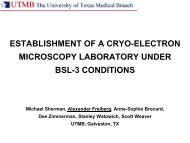Loss of Class II Type A2 Biological Safety Cabinet Containment in a ...
Loss of Class II Type A2 Biological Safety Cabinet Containment in a ...
Loss of Class II Type A2 Biological Safety Cabinet Containment in a ...
You also want an ePaper? Increase the reach of your titles
YUMPU automatically turns print PDFs into web optimized ePapers that Google loves.
<strong>Loss</strong> <strong>of</strong> <strong>Class</strong> <strong>II</strong> <strong>Type</strong> <strong>A2</strong> <strong>Biological</strong> <strong>Safety</strong> <strong>Cab<strong>in</strong>et</strong><br />
<strong>Conta<strong>in</strong>ment</strong> <strong>in</strong> a BSL-3 BSL 3 Laboratory Due to<br />
Supply Air Outlet Temperature<br />
Nick Flynn<br />
Director <strong>of</strong> Technical Services<br />
B & V Test<strong>in</strong>g, INC.<br />
Waltham, MA<br />
Bel Air, MD
Study Background<br />
B & V Test<strong>in</strong>g contracted by Broad Institute, Cambridge,<br />
MA to perform <strong>in</strong>-situ <strong>in</strong> situ conta<strong>in</strong>ment test<strong>in</strong>g <strong>of</strong> <strong>Class</strong> <strong>II</strong> type<br />
<strong>A2</strong> biological safety cab<strong>in</strong>et (BSC) with liquid reagent<br />
handler and spectrophotometer <strong>in</strong>stalled <strong>in</strong> new BSL-3 BSL 3 lab<br />
dur<strong>in</strong>g commission<strong>in</strong>g process
Study Background (contd)<br />
For comparative<br />
performance data evaluated<br />
conta<strong>in</strong>ment performance <strong>of</strong><br />
adjacent empty <strong>Class</strong> <strong>II</strong> <strong>Type</strong><br />
<strong>A2</strong> BSC<br />
Baker SG403A with canopy<br />
connection to build<strong>in</strong>g<br />
exhaust certified to<br />
NSF/ANSI 49 and<br />
manufacturer’s<br />
manufacturer s<br />
specifications
<strong>Class</strong> <strong>II</strong> BSC Performance<br />
Test<strong>in</strong>g Overview<br />
Microbiological challenge test: National Sanitation<br />
Foundation (NSF) 49 test <strong>of</strong> new BSCs performed under<br />
controlled environmental conditions <strong>in</strong> test laboratory at<br />
NSF or manufacturer site which quantifies performance<br />
Field test<strong>in</strong>g and certification: NSF/ANSI 49 Annex F, to<br />
ensure proper <strong>in</strong>flow and downflow air velocity set po<strong>in</strong>ts<br />
at which microbiological test performance data was<br />
established; also <strong>in</strong>cludes HEPA filter <strong>in</strong>tegrity test<strong>in</strong>g,<br />
airflow smoke patterns test<strong>in</strong>g and site <strong>in</strong>stallation<br />
assessment test<strong>in</strong>g where applicable
<strong>Class</strong> <strong>II</strong> BSC Performance<br />
Test<strong>in</strong>g Overview (contd)<br />
Bio-Analog Bio Analog Test 1 : factory and field test developed by<br />
the Baker Company which quantifies conta<strong>in</strong>ment<br />
and product protection performance <strong>of</strong> BSCs<br />
For conta<strong>in</strong>ment test utilizes sulfur hexafluoride (SF 6) )<br />
as tracer gas (ducted BSCs only)<br />
1. Field Test Quantify<strong>in</strong>g <strong>Biological</strong> <strong>Safety</strong> <strong>Cab<strong>in</strong>et</strong> <strong>Conta<strong>in</strong>ment</strong><br />
Performance, R.L. Jones, The Baker Company, Presented at 1994<br />
Annual Conference <strong>of</strong> American Industrial Hygiene Association
Study Methodology: Bio-Analog<br />
Bio Analog<br />
<strong>Conta<strong>in</strong>ment</strong> Test<br />
Tracer Gas: Gas<br />
SF 6 ~ 10,000 ppm @ 20 psi<br />
through NSF 6-jet 6 jet collision<br />
nebulizer w/H 2O Challenge Location: Location<br />
14” 14 above work surface<br />
centerl<strong>in</strong>e, 4” 4 back from<br />
viewscreen<br />
Detection Instrument:<br />
iTi Qualitek Leak Detector<br />
range .01-60 .01 60 ppm, probe<br />
1.5” 1.5 from access open<strong>in</strong>g,<br />
6.5” 6.5 above work surface
BSL-3 BSL 3 Lab<br />
Layout
BSL-3 BSL 3 Lab Constant Conditions<br />
Lab Pressure: - .06”w.g.( .06 w.g.(-15 15 pascals)<br />
Lab Supply Air: 1320 CFM Via<br />
Four 2’ 2 X 4’ 4 Term<strong>in</strong>al Ceil<strong>in</strong>g HEPA<br />
Filters and Two Diffusers (~ 250<br />
CFM/HEPA follow<strong>in</strong>g re-direction<br />
re direction<br />
<strong>of</strong> supply air to rear <strong>of</strong> lab)<br />
Lab Exhaust Air: 1500 CFM Via<br />
Four BSCs, One Exhaust Register<br />
and Autoclave Exhaust<br />
Cool<strong>in</strong>g Mode Supply Air Outlet<br />
Temperature: 58 - 63 degrees F (14<br />
-17 17 C) Note: outside air ~ 24 C
BSC Model SG403A Constant Conditions<br />
Passed microbiological challenge test<strong>in</strong>g<br />
performed at manufacturer’s manufacturer s test site<br />
Follow<strong>in</strong>g field <strong>in</strong>stallation and air balanc<strong>in</strong>g,<br />
tested and certified to NSF/ANSI 49 – 2007<br />
Annex F and manufacturer’s manufacturer s specifications by<br />
NSF-accredited NSF accredited biosafety cab<strong>in</strong>et field certifier<br />
Inflow velocity: 107 feet per m<strong>in</strong>ute (.54 m/s)<br />
Downflow velocity: 54 feet per m<strong>in</strong>ute (.27 m/s)<br />
Canopy duct connection: - .05” .05 w.g. (-12 ( 12 pascal)
BSC Model SG403A Conditions (contd)<br />
As component <strong>of</strong> NSF/ANSI 49 Annex F certification,<br />
passed Airflow Smoke Patterns Test<br />
F.4.1 Purpose<br />
This test...determ<strong>in</strong>es that there is no escape to the<br />
outside <strong>of</strong> the cab<strong>in</strong>et at the sides and top <strong>of</strong> the<br />
w<strong>in</strong>dow.<br />
F.4.3.2 View screen retention test<br />
Smoke shall be passed from one end <strong>of</strong> the cab<strong>in</strong>et to the<br />
other, 1.0 <strong>in</strong> (2.5 cm) beh<strong>in</strong>d the view screen at a height<br />
6.0 <strong>in</strong> (15 cm) above the top <strong>of</strong> the access open<strong>in</strong>g.
SG403A <strong>Conta<strong>in</strong>ment</strong> Test<br />
Scenarios<br />
Two Scenarios, Ten 5- 5<br />
M<strong>in</strong> Runs Each Scenario<br />
1) Warm<strong>in</strong>g Mode: HEPA<br />
filter supply outlet<br />
temperature 64 – 70<br />
degrees F (18-21 (18 21 C)<br />
2) Cool<strong>in</strong>g Mode: HEPA<br />
filter supply outlet<br />
temperature 58 – 63<br />
degrees F (14-17 (14 17 C)
SG403A <strong>Conta<strong>in</strong>ment</strong> Test<br />
Results<br />
Average SF 6 release concentration per 5 m<strong>in</strong> test runs<br />
<strong>Conta<strong>in</strong>ment</strong> protection factor/run (<strong>in</strong>terior SF 6<br />
concentration 10,000 ppm/average SF 6release release<br />
concentration)<br />
Number <strong>of</strong> peak releases SF 6/run /run due to periodic loss<br />
<strong>of</strong> conta<strong>in</strong>ment (peak release def<strong>in</strong>ed as SF 6 release <strong>of</strong><br />
> 0.10 ppm which results <strong>in</strong> loss <strong>of</strong> > one log<br />
protection factor)<br />
Average SF 6 peak release concentration/run<br />
Peak release conta<strong>in</strong>ment protection factor/run<br />
(<strong>in</strong>terior SF 6 concentration 10,000 ppm/average SF 6<br />
peak release concentration)
SF 6 ppm<br />
SG403A <strong>Conta<strong>in</strong>ment</strong> Results: Typical<br />
5 M<strong>in</strong>. Test Run Warm Supply Outlet<br />
Temperature Scenario (18-21 (18 21 C)<br />
Time (5 m<strong>in</strong>)
SF 6 ppm<br />
SG403A <strong>Conta<strong>in</strong>ment</strong> Results: Typical<br />
5 M<strong>in</strong>. Test Run Cold Supply Outlet<br />
Temperature Scenario (14-17 (14 17 C)<br />
Time (5 m<strong>in</strong>)<br />
Note: periodic SF 6 release verified with modified smoke test.
Efforts to Mitigate Periodic<br />
<strong>Conta<strong>in</strong>ment</strong> <strong>Loss</strong> <strong>in</strong> Cold<br />
Temperature Scenario<br />
Reduction <strong>of</strong> supply airflow <strong>in</strong> proximity to BSC access<br />
open<strong>in</strong>g from ~ 60 fpm to ~ 30 fpm—no fpm no change<br />
Re-direction Re direction <strong>of</strong> supply airflow away from BSC access<br />
open<strong>in</strong>g with 2’ 2 deep panel hang<strong>in</strong>g down from HEPA<br />
filter at 90 degrees—no degrees no change<br />
Re-direction Re direction <strong>of</strong> supply airflow away from BSC access<br />
open<strong>in</strong>g with 2’ 2 deep panel hang<strong>in</strong>g down from HEPA<br />
filter at 45 degrees angled away from BSC face—m<strong>in</strong>or<br />
face m<strong>in</strong>or<br />
improvement, still periodic conta<strong>in</strong>ment loss
SG403A <strong>Conta<strong>in</strong>ment</strong> Summary<br />
Results: Average SF 6 Release<br />
Concentration, Warm Supply Outlet<br />
Temperature Scenario (18-21 (18 21 C)<br />
SF 6 ppm<br />
Mean:<br />
< 0.01 ppm<br />
5-M<strong>in</strong>. M<strong>in</strong>. Test Runs
SF 6 ppm<br />
Mean:<br />
0.13 ppm<br />
SG403A <strong>Conta<strong>in</strong>ment</strong> Summary<br />
Results: Average SF 6 Release<br />
Concentration, Cold Supply Outlet<br />
Temperature Scenario (14-17 (14 17 C)<br />
5-M<strong>in</strong>. M<strong>in</strong>. Test Runs
Log Protection<br />
Factor<br />
Mean:<br />
6 logs<br />
SG403A <strong>Conta<strong>in</strong>ment</strong> Summary<br />
Results: <strong>Conta<strong>in</strong>ment</strong> Protection<br />
Factor per Test Run, Warm Supply<br />
Outlet Temperature Scenario (18-21 (18 21 C)<br />
5-M<strong>in</strong>. M<strong>in</strong>. Test Runs
Log Protection<br />
Factor<br />
Mean:<br />
4.4 logs<br />
SG403A <strong>Conta<strong>in</strong>ment</strong> Summary<br />
Results: <strong>Conta<strong>in</strong>ment</strong> Protection<br />
Factor per Test Run, Cold Supply<br />
Outlet Temperature Scenario (14-17 (14 17 C)<br />
5-M<strong>in</strong>. M<strong>in</strong>. Test Runs
SG403A <strong>Conta<strong>in</strong>ment</strong> Summary<br />
Results: Number <strong>of</strong> Periodic Peak<br />
Releases Per Test Run, Warm Supply<br />
Outlet Temperature Scenario (18-21 (18 21 C)<br />
Number Peak<br />
Releases*<br />
Mean:<br />
< 1 Peak<br />
Releases<br />
* > 0.10 ppm release<br />
5-M<strong>in</strong>. M<strong>in</strong>. Test Runs
SG403A <strong>Conta<strong>in</strong>ment</strong> Summary<br />
Results: Number <strong>of</strong> Periodic Peak<br />
Releases Per Test Run, Cold Supply<br />
Outlet Temperature Scenario (14-17 (14 17 C)<br />
Number Peak<br />
Releases*<br />
Mean:<br />
4.6 Peak<br />
Releases<br />
* > 0.10 ppm release<br />
5-M<strong>in</strong>. M<strong>in</strong>. Test Runs
Mean:<br />
0.3 ppm<br />
SG403A <strong>Conta<strong>in</strong>ment</strong> Summary Results:<br />
Average Peak Release Concentration<br />
Per Test Run, Warm Supply Outlet<br />
Temperature Scenario (18-21 (18 21 C)<br />
SF 6 ppm<br />
5-M<strong>in</strong>. M<strong>in</strong>. Test Runs
Mean:<br />
1.73 ppm<br />
SG403A <strong>Conta<strong>in</strong>ment</strong> Summary Results:<br />
Average Peak Release Concentration<br />
Per Test Run, Cold Supply Outlet<br />
Temperature Scenario (14-17 (14 17 C)<br />
SF 6 ppm<br />
5-M<strong>in</strong>. M<strong>in</strong>. Test Runs
SG403A <strong>Conta<strong>in</strong>ment</strong> Summary Results:<br />
Peak Release <strong>Conta<strong>in</strong>ment</strong> Protection Factor<br />
per Test Run, Warm Supply Outlet<br />
Temperature Scenario (18-21 (18 21 C)<br />
Log Protection<br />
Factor<br />
Mean:<br />
5.9 logs<br />
5-M<strong>in</strong>. M<strong>in</strong>. Test Runs
SG403A <strong>Conta<strong>in</strong>ment</strong> Summary Results:<br />
Peak Release <strong>Conta<strong>in</strong>ment</strong> Protection Factor<br />
per Test Run, Cold Supply Outlet<br />
Temperature Scenario (14-17 (14 17 C)<br />
Log Protection<br />
Factor<br />
Mean:<br />
3 logs<br />
5-M<strong>in</strong>. M<strong>in</strong>. Test Runs
Outcomes<br />
Certification <strong>of</strong> SG403A was voided until<br />
supply outlet temperature controls were<br />
modified to ma<strong>in</strong>ta<strong>in</strong> specification > 17 C<br />
Other BSCs <strong>in</strong> BSL-3 BSL 3 were evaluated utiliz<strong>in</strong>g<br />
Bio-Analog Bio Analog test and demonstrated adequate<br />
conta<strong>in</strong>ment performance when supply air<br />
outlet temperature was > 17 C (<strong>in</strong>clud<strong>in</strong>g<br />
SG603A with <strong>in</strong>stalled equipment)
Conclusions/Recommendations<br />
Supply air outlet temperature <strong>of</strong> air sources <strong>in</strong> close<br />
proximity to <strong>Class</strong> <strong>II</strong>, <strong>Type</strong> <strong>A2</strong> biological safety cab<strong>in</strong>ets<br />
under certa<strong>in</strong> laboratory conditions may adversely impact<br />
BSC conta<strong>in</strong>ment performance<br />
Airflow smoke patterns test<strong>in</strong>g as described <strong>in</strong><br />
NSF/ANSI 49 2007 may be <strong>in</strong>adequate to accurately<br />
assess BSC conta<strong>in</strong>ment performance under certa<strong>in</strong><br />
laboratory conditions. Consideration should be given to<br />
amend Annex F to describe rate <strong>of</strong> smoke scann<strong>in</strong>g<br />
dur<strong>in</strong>g view screen retention test to facilitate<br />
identification <strong>of</strong> potential periodic conta<strong>in</strong>ment failures<br />
For critical and/or questionable BSC <strong>in</strong>stallations, field<br />
certification should be performed with supply air systems<br />
operat<strong>in</strong>g <strong>in</strong> “worse worse-case case” scenarios (at coldest/max set-<br />
po<strong>in</strong>ts)
Acknowledgements<br />
Dr. James Gomez, Ph.D., Broad Institute<br />
Dan Ghidoni, PE, CIH, Northeast<br />
Scientific Associates<br />
Aaron Johnson, The Baker Company


